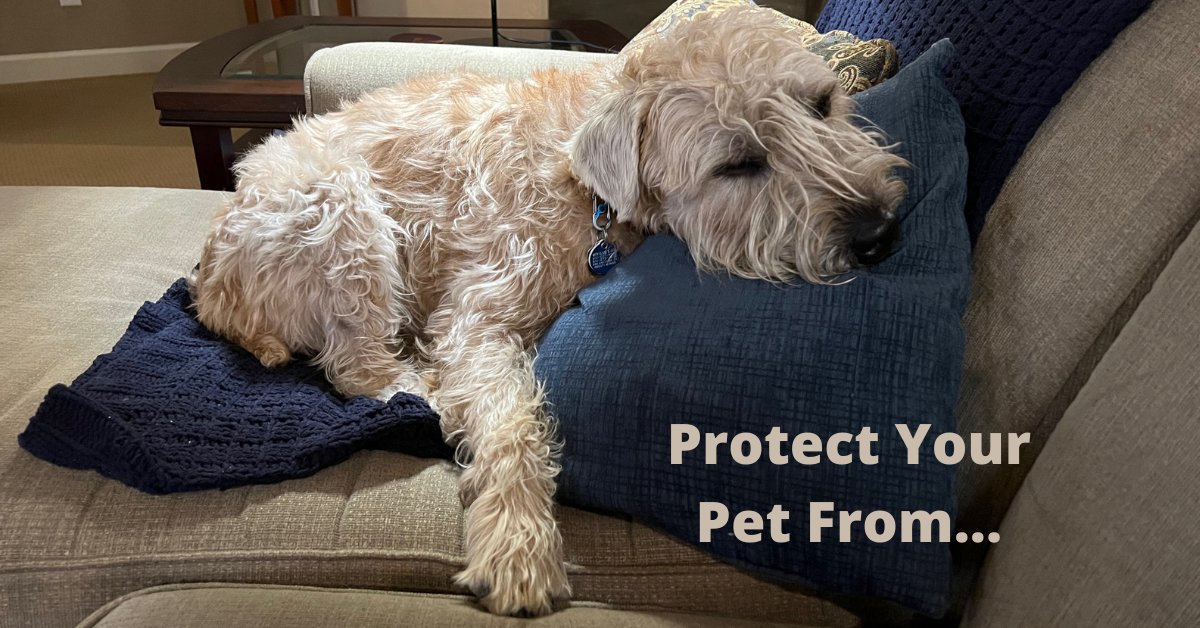After living in Minneapolis for a zillion years, I knew how to protect my dog in the city. I protected my dog with monthly heartworm protection, fleas/ticks, Bordetella for boarding, distemper, etc.
Then we moved to Arizona without a pet. When Gizmo arrived, I wondered how do I protect my dog in Arizona?
How do you protect your dog and cat from the environment and the diseases wildlife carry? In the past few years, you have more options to protect your pet from many more diseases and situations.
Rabies
Yes, rabies vaccines are required for dogs in the United States.
Rabies vaccines are not legally required for cats. Talk with your veterinarian about your indoor/outdoor cat’s needs for rabies shots based on the cat’s lifestyle. Do you need to protect your cat?
Leptospirosis
I heard about Leptospirosis or Lepto. When I lived in Minnesota, it wasn’t a big deal. Now I’m hearing veterinarians are suggesting the annual vaccine.
Why? Our pets share nature with squirrels, deer, rats (or packrats in Arizona), skunks, and more! Lepto passes from infected animals through urine to water puddles, streams, lakes, and even the soil. Yikes!
What’s scarier is Lepto can be passed from our pets to us.
Following our vet’s recommendation, Gizmo received his annual Lepto vaccine. Yes, I protect my dog from Lepto.
Rattlesnakes
Then I asked our vet, “what do you think of rattlesnake vaccines?” Her replied, “it’s still rattlesnake venom!” She recommended rattlesnake training to teach Gizmo avoidance.
I was very nervous about taking 8-month-old Gizmo to the training. Rattlesnake Ready uses e-collars! E-collar training is not part of my practices and I needed to understand the reason and it’s use. I decided it was how I would protect my dog, Gizmo.
At our session we met Cody, the snake wrangler!
Cody explained he uses e-collars to get Gizmo’s attention at the exact second Gizmo is getting too close. I mentioned Gizmo is sensitive, and Cody understood and used an appropriate setting. Now for Gizmo to experience the 4 stations.
Now for Gizmo to experience the 4 stations.
First station, Gizmo and I approached a baby rattlesnake whose mouth had 3M medical tape to protect us from bites. Cody zapped Gizmo as we approached, and Gizmo acknowledge the baby. Both of us jumped and Gizmo landed on his back. I was shaken. Gizmo got up and was fine. I was breathing fast!
Second station, we walked downwind from a fresh shed rattlesnake skin to learn the scent of a snake. Gizmo was interested and he got another shock. He came to me.
Third station was a bush with a hidden speaker making the sound of a snake’s rattler. Gizmo alerted to the sound and kept walking. Cody told me if I ever hear a snake rattler, we are too close!
Final station was the HUGE rattlesnake with mouth protection. Cody told me to approach it with Gizmo. As we got closer, Gizmo quickly walked behind me. Gizmo passed and received a certificate!
One Year Later
Two weeks ago was a year since our first rattlesnake training. For his re-test, Gizmo only had one station – the huge rattlesnake.
Cody told us where to wait as he placed the snake about 15 feet away. Immediately Gizmo was alert and concerned.
Cody said to approach the snake and wait for Gizmo’s reaction.
As we approached the snake slowly started moving. Suddenly Gizmo is next to my left side. While keeping his rear feet on the ground, he climbed until he reached my waist. He stayed there. This is NOT a normal position for him.
I praised him and gave his lots of treats. He passed the test!
Yes, annually we’ll go for a re-test! Yes, I trust Cody’s training to protect my dog from rattlesnakes.
I’m grateful Gizmo will give me a sign when he sees a rattlesnake.
Your Next Steps
Check with your veterinarian about how to protect your dog and cat for their lifestyle.
When you travel, research the type of environment you’ll be in and if your pet needs more protection. Safe travels!
Concerned about your Pet? Schedule a free 15-minute phone consultation to understand how I can help you and your pet.





